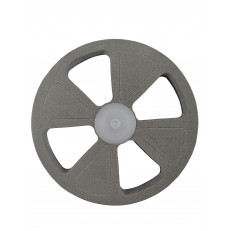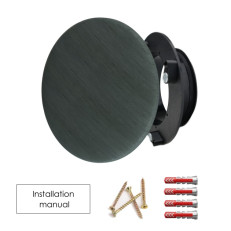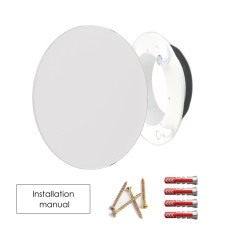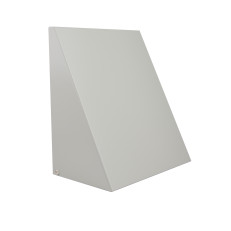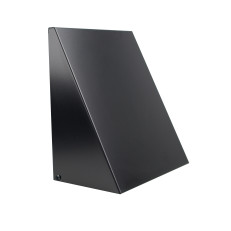Recovery vs. air conditioning
Ventilation with recovery vs. air conditioning
Let's start by explaining the concept of air conditioning and the differences from ventilation with heat recovery.
The difference between air conditioning and passive ventilation with recuperation is mainly in the air conditioning. If we use the term air conditioning , then the supplied air is modified , usually by changing the temperature and the possibility to change the humidity .
This can also be done with ventilation with heat recovery (recovery), but in the absence of another exchanger, the change in the temperature of the supplied air is only in the power of physics and input conditions. We cannot get colder or warmer air of any temperature into the house by turning any wheel on the controller during recuperation. We will always move within the limits of outdoor and indoor temperature.
The term air conditioning is often perceived by the lay public as an element that also supplies fresh air. However, this is a fundamental mistake, especially in residential ventilation. The so-called split units only adjust the temperature of the indoor air , but do not supply outdoor air .
Everything is mainly related to the very low value of the heat capacity of the air . Where it is possible to run several kW of heat or cold using water/refrigerant through a tiny tube very quietly at high flow rates, the pipe carrying the air would have to be several times larger and with big problems with noise, pressure losses and thermal insulation. It is probably clear to everyone that this is not a problem for industrial plants, but for apartments or family houses, this solution is not entirely suitable.
Specific heat capacity (0 °C):
Air: 1.01 kJ/kg.K
Water: 4.18 kJ/kg.K
Comparison of the required pipe size to transfer the same amount of heat and cold of different media:
Due to the requirements for increased comfort, especially in the summer months, we encounter a large number of requests for a combination of a recovery system and air conditioning .
We therefore offer you the following solutions:
1) Passive recovery + air-to-air heat pump (split) – both systems are installed separately.
The recovery system helps to distribute heat/cool around the house faster. This is a system that can be used not only in extremes of outdoor temperatures, but the air conditioner can be used for heating in a transitional period when it is not appropriate to switch on the primary heat source (e.g. floor heating or activate radiators). This system enables heating and cooling of the interior in a very short time. However, it is necessary for family houses to install several indoor units, we recommend at least one split 3-5kW on each floor.
Air conditioning distribution systems should calculate with the position of indoor air conditioning units so that the intake air temperature is not too low and condensation does not occur.
2) Passive recovery + water heat exchanger (source e.g. heat pump (x)-water)
The water exchanger is mounted behind the recuperation unit on the supply air pipe (in front of the distributor). The heat exchanger is connected to the heat/cooling source of the heating system (can be used for cooling only if you have a heat pump with the possibility of reverse operation). With this solution, it is necessary to ensure the regulation of the water temperature so that the air temperature is not too low or high and again there is no risk of condensation of water vapor in the pipe/on the pipe or damage to the plastic pipe (regulation is usually provided by the heating profession). Recovery units with better control options can control the mixing node, etc. Usually, however, a traditional valve/head with a sufficient temperature range will suffice.
We recommend using a cooler rather than a heater as an exchanger. Although the heating output will be slightly lower, the coolers have a condensate drain, which the heaters lack.
3) Solution 2) + CIRCULATION
The solution described in point 2) can be made more efficient by using air circulation.
In most recuperation units for RD, the supply air contains 100% outdoor air. However, there are also units that can use part of the indoor air (from clean rooms), adjust the temperature and mix it with only the necessary amount of fresh intake air from outside. Depending on the possibility of controlling the recuperation units, mixing takes place permanently or fresh air is supplied only intermittently (e.g. only 10' per hour).
With solutions 2) and 3), there is already a problem with the relatively small amount of kW that the system can transfer with the help of air. This is connected to the need for a greater number of pipes, thermal insulation, noise elimination, etc.
Furthermore, it is necessary to remember the fact that the supply outlet for warm air heating should be near the floor from the point of view of air distribution, but in cooling mode, on the contrary, it should be under the ceiling. The ceiling option is usually chosen.
UNITS WITH THE OPTION OF CIRCULATION:
DUPLEX WITH REGULATION RD5 (new aM) (necessary to add the connection of the intake and exhaust branches + control flaps and actuators)
4) Active recovery units with outdoor unit
They are units usually with the possibility of internal air circulation, which have an integrated heat exchanger and can be connected to a heat/cold source (outdoor condensing unit) with which they communicate directly.
Units usually have 5 nozzles. 5. the neck is usually used for the so-called circulation air outlet. It should be noted that this is a relatively expensive system with a small amount of kW of heat/cool transferred, but it is fully controllable so everything can be controlled from one controller.
DUPLEX UNITS RA5, RB5, RK5 + ORDER EXTERNAL PART, EXCHANGER, ETC.
JABLOTRON FUTURA + CoolBreeze module
5) Active recovery units without outdoor unit
For these units, we are not sure if these units can still be called recuperative. They do use waste heat, but to use it, they use a relatively large amount of energy to run the heat pump all year round. They do not have a recuperation exchanger (recuperator). The system is usually not sufficient for quality cooling or heating, it is expensive and has high consumption. Therefore, we do not usually install this system for our clients.
6) Ground exchanger for suction
This solution is not among the non-mechanical systems that can regulate the temperature. Again, temperature limits are determined only by natural conditions. This solution requires consultation with a designer to determine whether the rock is suitable. In addition, it is necessary to work with the certainty of the formation of condensate in pipes underground, the cleanability of the system, etc. For systems with an underground heat exchanger, we also recommend installing classic suction above ground level (on the wall).
Last edited by:
30/03/2020


